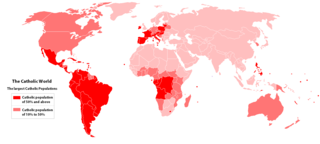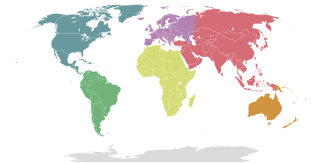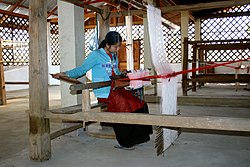Tourism is the fastest growing industry in Laos. It is governed by a ministry-level government agency, the Lao National Tourism Administration, located in Vientiane.

Luang Prabang International Airport, is one of the few international airports in Laos. The airport is located about 4 kilometres (2.5 mi) from the centre of Luang Prabang. The second busiest airport in the country, it is a regional hub for international flights to Bangkok, Chiang Mai and Siem Reap and other cities such as Vientiane and Phongsaly. The airport underwent significant expansion work in 2012-3, when it was upgraded and expanded, and the runway enlarged.

The French protectorate of Laos was a French protectorate forming part of the French Colonial Empire in Southeast Asia. It consisted of much of the territory of the former kingdom of Lan Xang and was part of French Indochina from 1893 until it was granted self-rule within the French Union in 1946. The Franco-Lao Treaty of 1953 establishing Laos as an independent member of the French Union. Under the Geneva Conference following France's withdrawal from Indochina after the First Indochina War, Laos was granted independence in 1954.

The Apostolic Vicariate of Luang Prabang is a Latin rite jurisdiction of the Catholic Church in Laos. As an apostolic vicariate, it is a pre-diocesan jurisdiction, entitled to a titular bishop. It is located in northern Laos.

The Catholic Church in Laos is part of the worldwide Catholic Church, under the spiritual leadership of the pope in Rome. The Catholic Church is officially recognized by the Lao Front for National Construction.

Christianity is a minority religion in Laos. Christians in Laos number 150,000, divided approximately equally between Protestant and Catholics. There are three major Churches in Laos: the Lao Evangelical Church, the Seventh-day Adventist Church and the Roman Catholic Church. The Laotian government has enacted legislation aimed against Christians, and heavily monitors all Christian activities.

The Apostolic Vicariate of Vientiane is a territorial jurisdiction of the Catholic Church located in northern Laos.

Route 13 is the most important highway in the country of Laos. It begins at Boten in the North of Laos at the Chinese border. It connects the city of Vientiane to Luang Prabang in the north and roughly follows the line of the Mekong River down to the border with Cambodia. The road then continues at National Highway 7 in Cambodia. Also this national highway leads past all three international airports in Laos Vientiane Airport, Luang Prabang Airport and Pakse Airport. Between Boten and Nateuy the Route 13 is at a length of 20 km part of the Kunming-Bangkok Expressway, which is also part of the Asian Highway AH3. From Nateuy to Vientiane, the Route 13 is part of the AH12 and from Vientiane to the border of Cambodia AH11.
Hans Georg Berger is a German-born photographer and writer, who lives in Berlin, Elba and in Laos.

The Luang Prabang Range, named after Luang Prabang, is a mountain range straddling northwestern Laos and Northern Thailand. Most of the range is located in Sainyabuli Province (Laos), as well as Nan and Uttaradit Provinces (Thailand), with small parts in Phitsanulok and Loei Provinces. Several rivers such as the Nan, Pua and Wa river, have their source in this range. Phu Fa waterfall, the biggest and the tallest waterfall in Nan Province, is also located in these mountains. This range is part of the Luang Prabang montane rain forests ecoregion.
Phanaʼ is a Loloish language of Laos and China. Phanaʼ is spoken by 500 people in Laos. In China, it is spoken in Mengla County, Yunnan Province. It is closely related to Sila, which is spoken by 2,000 people in Laos and Vietnam. Badenoch reports that it is similar to.

Ban Xang Khong or Ban Sang Khong is a village in Luang Prabang Province, Laos. It is located about 5 kilometres (3.1 mi) east of Luang Prabang. The Lue peoples of this village are noted in particular for their arts and crafts. The locals are adept at making traditional Saa paper, which is made from mulberry trees. There are several bamboo bridges in the area, and the village can be approached on foot from Luang Prabang.
The Tat Sae Waterfalls, also referred to as the Tad Sae Waterfalls are waterfalls located along a tributary of the Nam Khan River in Luang Prabang Province, Laos. They are located about 18 kilometres (11 mi) southeast of Luang Prabang and about 2 kilometres (1.2 mi) from the village of Bak En. The falls flow over limestone formations amongst trees.

Xayabuli is a province of Laos, located in the northwest of the country. Xayabuli Province covers an area of 16,389 square kilometres (6,328 sq mi). The province borders Bokeo Province and Oudomxai Province to the north, Luang Prabang Province and Vientiane Province to the east, and the Thai provinces Loei, Phitsanulok, Uttaradit, Nan and Phayao.
Operation Xieng Dong was a successful defensive strike by the Royal Lao Army (RLA) against an invasion by the People's Army of Vietnam (PAVN). In early February 1971, PAVN forces swept RLA defenders from a line of hilltop positions guarding the royal capital of Luang Prabang. The city's perceived invulnerability to attack was shattered. King Sisavang Vatthana refused to leave his capital. Other Military Regions of Laos hastily forwarded to Luang Prabang's Military Region 1 any troops that could be spared from the rest of the Laotian Civil War. On 7 April, the resulting patchwork force of RLA battalions, Forces Armee Neutraliste half regiment, and Central Intelligence Agency-backed Special Guerrilla Units managed a three-pronged offensive supported by tactical aviation that surrounded and defeated the invading PAVN 335th Independent Regiment, which had gotten within eight kilometers of Luang Prabang. By 5 June 1971, the 335th was in full retreat.

Khokmanh or Ban Khokmanh is a village in Mueang Luang Prabang, Khoueng Luang Prabang in Laos.















